|

Kazuo Shiraga, Dozo ohairi kudasai (Please Come In), 1955.
Even at the dawn of the 21st Century, Western art history has not always taken into account the
astounding innovative power of the Japanese avant-garde whose three strongest moments are represented by the groups MAVO,
GUTAÏ, and NEO-DADA. Art is one of the biggest victims of ignorance,
power, and the media and their economic and political dictates.
Faced with the onslaught of information, let us dare to question what both
the media and the markets of dominant thought tell us to think. Today when we regularly confuse art and culture, invention and expression, it is good
to remind oneself of the battles over ideas of form and color waged by a few artists who demanded and desired to change life
itself.
Gutaï is still current, and we are starting to see exhibitions of
the group’s work in major cities. Their relevance lies in their relationship with young artists who are discovering
modern and contemporary art, since all of Gutaï’s experiments are now reappearing in the work of young artists most
of whom know nothing about Gutaï and have no desire to remake installations, performances, and actions from more than half
a century ago. In order for this generation to carry its work forward, it is important that it know the works and adventures
of this Japanese group, which reinvented what Dada had started using their bodies as the central medium of their art immediately
after Pollock’s American abstraction was in full swing and at the same time as Allan Kaprow.
I
wrote this text for this new generation as a kind of introduction to my website www.gutai.com.
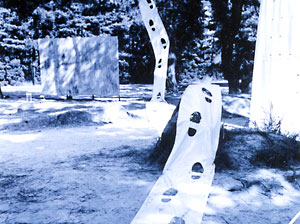
Akira Kanayama, Ashiato (1956).
Gutaï Already Did It !
Fire arrows of color on a huge canvas Dig holes
in the ground and illuminate them Paint using a cannon filled with enamel
paint Enclose yourself in a sack hanging from a tree Burst through paper screens Fight with your
entire body against concrete before it sets
In June of 1956, Gutaï already did it!
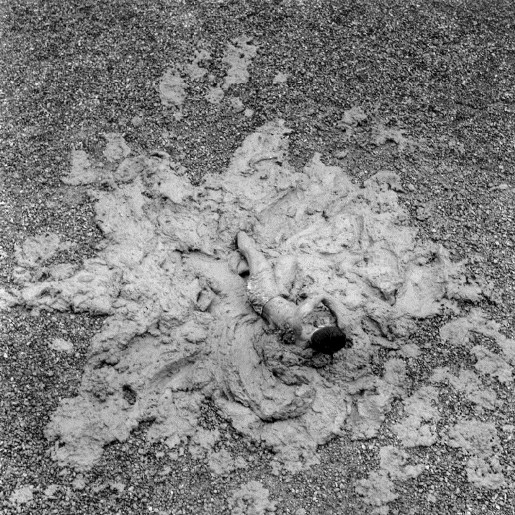
Kazuo Shiraga, Doro ni idomu (Challenging Mud), 1955.
Paint using an electric vibrator Make a canvas 100 meters long that rises into
the trees Fashion
a coat of lightbulbs Use a remote-controlled toy to draw a line Launch kites as abstract paintings Paint with your feet
In July of 1956,
Gutaï already did it!
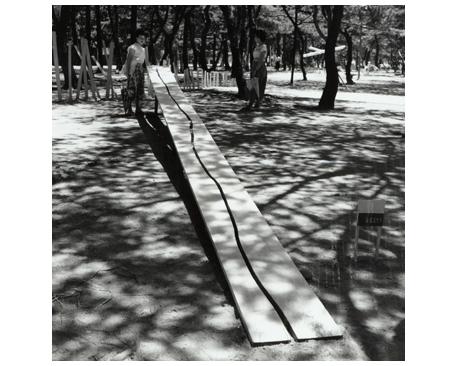
Fujiko Shiraga, White Board, 1955.
Trap air in plastic as a sculpture Paste mirrors into a painting Paint with a watering can Create
a canvas frame to observe the sky as a painting Make an action painting on metal using acid Accumulate oil cans
In July of 1956, Gutaï
already did it!
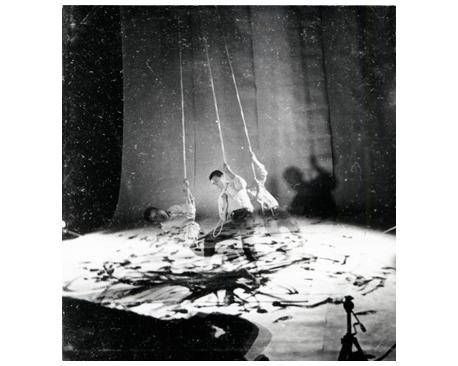
Kazuo Shiraga, The Artist Painting with His Feet, 1956.
Exhibit a billboard covered in graffiti Exhibit sheets painted in monochromes Exhibit stakes lined up in the ground Exhibit smoke rings Exhibit railroad crossing warning
signals Exhibit round sculptures inflated
with hydrogen
In July of 1956, Gutai did it
already !
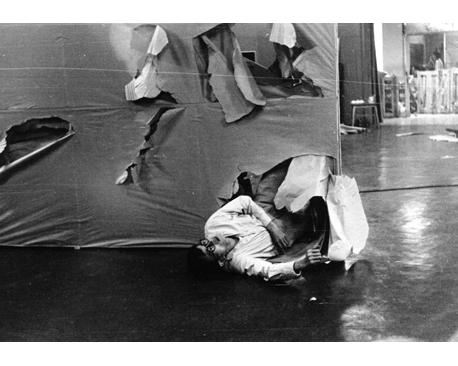
Saburo Murakami, Sakuhin (Work) (Paper Break Through), 1956.
INSIDE GUTAI
A l'aube du XXIeme
siècle, le monde occidental n'a toujours pas pris en compte, dans son histoire
de l'art, l'étonnante force novatrice des avant-gardes japonaises dont les
trois moments forts furent marqués par les groupes MAVO, GUTAI et NEO-DADA.
On sait que l'art est une des grandes victimes de l'inculture, des pouvoirs et
des médias et de leurs diktats économiques et politiques.
Nous devons revisiter le labyrinthe de l'histoire de l'art afin de réhabiliter
certains artistes et groupes d'artistes restés injustement dans l'ombre, qui,
avec le recul apparaissent comme d'importants novateurs.
Face à la déferlante de l'information, osons remettre en question ce que nous
dictent les médias, et les marchés de la pensée dominante.
Aujourd'hui où on confond, art et culture, invention et expression, il est bon
de se rappeler ces combats d'idées de formes et de couleurs menés par quelques
artistes, leurs exigences et leur volonté à vouloir changer la vie.
Gutai est toujours
d’actualité, on commence à voir dans les grandes capitales de plus en plus
d’expositions. Son actualité ne peut
être que sa relation avec les jeunes artistes qui découvrent l’art moderne et
contemporain car toutes les expériences de Gutai se retrouvent aujourd’hui dans
les œuvres de nos jeunes artistes, la plupart d’entre eux ignorant Gutai et
sans le vouloir faisant des remakes d’installations, de performances et
d’actions diverses qui ont aujourd’hui plus d’un demi siècle.
Afin que cette
nouvelle génération puissent porter plus loin son art, est important qu’elle
connaisse les œuvres et l’aventure unique des participants de ce groupe
japonais qui, à la suite immédiate de l’abstraction américaine de Pollock
battait son plein et dans le même temps que Allan Kaprow, réinventèrent ce que
Dada avait lancé, faisant de leur corps l’outil central de leur art.
C’est pour cette
nouvelle génération que j’ai écris ce texte qui est comme une introduction
au site que j’ai réalisé www.gutai.com
Gutaï
l’a déjà fait !
Tirer à l’arc des flèches de couleur sur une immense toile
Creuser des trous
dans la terre et les éclairer
Peindre à l’aide d’un canon bourré de peinture émaillée
S’enfermer dans
un sac pendu à un arbre
Traverser
des écrans de papier
Lutter de tout son corps dans du béton avant sa prise
En juillet 1956 Gutaï l’a déjà
fait !
Peindre à l’aide d’un
vibreur électrique
Faire une toile de 100m de long qui monte dans des arbres
Confectionner un manteau d’ampoules
éclairantes
Téléguider un jouet qui inscrit une ligne
Lancer des cerfs-volants en tant que peintures abstraites
Peindre
avec les pieds En juillet 1956
Gutaï l’a déjà fait !
Coller des miroirs dans un tableau
Peindre avec un arrosoir
Créer un cadre de toile pour observer le ciel comme un
tableau
Faire de la peinture d’action sur du métal avec de l’acide
Accumuler de bidons d’huile
En
juillet 1956
Gutaï l’a déjà fait !
Exposer un panneau couvert de graffitis
Exposer des draps peints monochromes
Exposer
des piquets alignés dans le sol
Exposer des ronds de fumée
Exposer des signaux d’alarme de passage à niveau
Exposer
des sculptures rondes gonflées à l’hydrogène<
En juillet 1956
Gutaï l’a déjà fait !

Michel Batlle is an artist of Catalan origin based outside
of Toulouse, France. He
is the founder of several journals, including Articide Circuit,
established in
1993.
http://michelbatlle.free.fr/cv.htm
|
